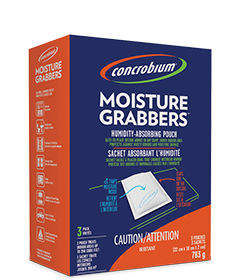How to Remove Mold in the Bathroom
Bathrooms are prime ‘hot spots’ for household mold.
Your bathroom can be a breeding ground for mold and mildew, largely due to poor ventilation, water and humidity sources but mold doesn’t have to be a foregone conclusion. Manage humidity with Concrobium Moisture Grabbers and if you do encounter any mold, use Concrobium Mold Control to clean and remove mold in the bathroom: in shower stalls, bath tubs, behind toilets, in cabinets and on ceilings, tiles and walls.

-
Shower Tub & Stall
- Spray Concrobium Mold Control to affected areas and allow surfaces to dry completely. A thin, even application is all that’s required.
- Clean the surface with a Concrobium-dampened cloth or brush. Ensure there is a nice even coat left on the surface after cleaning to help provide mold resistance.
- For areas like shower stalls and tubs that receive large amounts of dousing, apply Concrobium Mold Control every 1-2 months to re-apply the preventative microbial barrier.
Tip
Help prevent mold by ensuring proper bathroom ventilation. Ensure a ventilation fan is properly installed and run it often to reduce bathroom humidity. -
Walls, Ceiling & Cabinetry
- Spray Concrobium Mold Control on the moldy surface, allow to dry. Make sure the surface is completely dry prior to application; a thin, even application is all that’s required.
- Clean the surface with a Concrobium-dampened cloth or brush. If mold staining remains, you may have to take additional cosmetic steps like re-painting, or try using Concrobium Mold Stain Eraser to remove deeply embedded or stubborn staining left by mold to improve the look of the surface.
- As a final step after cleaning, reapply Concrobium Mold Control to leave a thin layer of the solution on the surface to protect against future mold growth.
NOTE
As bathrooms receive repeated exposure to water and humidity, you may be required to reapply the product every 1-2 months or as required to ensure resistance against mold re-growth.Tip
Help prevent mold by ensuring proper bathroom ventilation. Ensure a ventilation fan is properly installed and run it often to reduce bathroom humidity. -
Grout & Caulking
- Spray Concrobium Mold Control on the affected caulking & grout and allow to dry. Make sure the surface is completely dry prior to application.
- Because tile grout and caulking is quite porous, mold that has grown into it over the course of time may be very difficult to remove. Use Concrobium Mold Control with a stiff bristle brush to scrub the affected surface to eliminate tile grout mold.
- For tough and embedded black mold stains, try our Concrobium Mold Stain Eraser. If grout is very mold-stained, you may need to reapply the Concrobium Mold Stain Eraser and apply a light agitation. If these attempts are unsuccessful, you may need to replace the grout/caulking altogether. Spray Concrobium into the cavities once you’ve removed the grout/caulking – and then spray the newly-applied grout for mold prevention.
- Finally, re-apply Concrobium to leave a thin layer of the solution on the surface to protect against mold. Reapply as required, depending on the amount of dousing the surface receives.
NOTE
As bathrooms receive repeated exposure to water and humidity, you may be required to reapply the product every 1-2 months or as required to ensure resistance against mold re-growth.Tip
Help prevent mold by ensuring proper bathroom ventilation. Ensure a ventilation fan is properly installed and run it often to reduce bathroom humidity. - Behind Toilets
As water accumulates behind toilets and bathroom fixtures, these areas can become prime targets for mold and mildew growth. Be sure to clean these spots regularly to ensure that water is quickly removed from the area.
If leaky pipes or condensation create moisture issues in these areas, be sure to address the issue, and treat the area with Concrobium Mold Control by applying the product in a thin, even layer over the affected surface to eliminate existing mold and prevent re-growth.
For tough, embedded mold staining on tile grout work, drywall or fixtures, try Concrobium Mold Stain Eraser to easily remove mold stains with no scrubbing.
Tip
Help prevent mold by ensuring proper bathroom ventilation. Ensure a ventilation fan is properly installed and run it often to reduce bathroom humidity.


